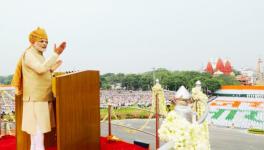Utter Disgrace! Modi Sarkar Refuses Hike in Rs 200 Monthly Old Age Pension
Represenational use only.
Junior Minister for Rural Development in the Central government, Sadhvi Niranjan Jyoti, ruled out in Parliament any increase in the amount of monthly pension given by the Centre to the elderly under the National Social Assistance Programme (NSAP). The amount currently being given to each beneficiary under this programme is a princely sum of Rs 200 per month for persons between ages 60 and 79, and Rs 500 per month for persons of 80 years and above!
It is a shame and a disgrace that the Central government offers such an utterly paltry sum to aged citizens. What is more, this sum has not changed for years; it is not even inflation-indexed. State governments add a little bit to what the Centre offers, but this at best brings the amount to Rs 500 per month. This is about the maximum that an elderly person who is not on any institutional pension scheme receives in India by way of pension.
What is more, a large number of persons who should be receiving this amount do not even do so. In 2016-17, the total amount given as pension under the NSAP by the Central government was roughly Rs 5,900 crore which, at Rs 200 per month, works out to only 2.46 crore beneficiaries.
This is only a fraction of the number that should be receiving government pension. The total number of persons above 60 is estimated to be about 12 crore, which is roughly 10% of the country’s total population. Of this, the proportion that is not on any institutional scheme may be taken to be roughly equal to the proportion engaged in the informal sector, namely, about 85%. In which case, the number of people who should be receiving pension from the government comes to almost 10 crore.
In agriculture alone, which accounts for nearly half the total workforce of the country, the number should be 5-6 crore. When we consider those engaged in other sectors, such as retail trade, unorganised manufacturing and petty services, it is clear that the actual beneficiaries are just about a quarter of the number that should be getting government pension. The government’s pension scheme, in short, is utterly ridiculous -- it pays a trivial sum of Rs 200 per month and that too only to about a quarter of the number that should be getting it.
Against this, civil society organisations have been demanding that the pension should be around half of the minimum wage. Of course, the statutory minimum daily wage varies across states, but if we take Rs 300, which is enacted in some states as the figure that should prevail, then the pension amount should be Rs 4,500 per month. In fact, however, Rs 3,000 per month at current prices has been the typical demand by several of these organisations.
The argument for the government’s ensuring pensions for all arises from the principle that no democratic society should expect old people to live off their progeny after retirement. A pension should be a matter of right for all citizens. For a vast number of persons who either get no pensions under any institutional schemes, or earn incomes that are so low that they can scarcely be expected to save for their old age from incomes earned during their working years, the government must make the necessary pension provisions.
The responsibility of the government, in turn, arises from the fact that the relative income a person gets, which is embedded in the pattern of income distribution in the country, is socially determined. Hence, it is the responsibility of society to ensure that a pension adequate for a decent living is provided to all, and this responsibility devolves on the government as the avowed executor of society’s will.
To rule out an increase in the pathetic pension currently being given, therefore, amounts to an utterly callous and unpardonable abdication of responsibility by the government. It is more in keeping with the ethos of a feudal caste-ridden society where the poor are “kept in their places” by denying them adequate living standards, rather than a modern democratic society where a citizen is recognised as having a right to a pension.
The question of resources required toward this end should in principle be irrelevant: resources simply have got to be found. If say 10 crore persons have to be given Rs 3,000 per month, then the total resources required for it is Rs 3.6 lakh crore per annum, which is roughly 1.8% of India’s GDP. If 1.8% of gross domestic product (GDP) is spent by the government on pensions, then the pensioners will spend this amount buying various goods and services which will accrue as incomes to the producers of these goods and services and they in turn will spend some of this, and so on, generating additional incomes through successive rounds of spending.
A very conservative estimate of the total additional income generated by the government spending 1.8% of GDP is 3.6% of GDP (that is, a multiplier of two), on which the tax revenue that would accrue to the government, taking Centre and states together assuming a 15% tax-GDP ratio, will be 0.54% of GDP. Therefore, to spend 1.8% of GDP, fresh resources that need to be raised by the government come to roughly 1.26% of GDP (namely, 1.8 minus 0.54).
This should not be a problem at all for a government that is serious about instituting a pension scheme. If private wealth is taken, at a very conservative estimate, to be four times the GDP, which is consistent with the observed capital-output ratio in the country, and if the top 1% of the population is assumed to own half of the total private wealth, again at a very conservative estimate, then the wealth of this segment comes to twice the GDP. A mere 0.63% wealth tax, levied on the wealth of only the top 1% of private wealth-holders, is enough to raise the resources required to run an almost universal pension scheme that leaves out only those who are institutionally protected.
A wealth tax, it may be noted, has been recently mooted for instituting welfare state measures in the United States. Both Bernie Sanders and Elizabeth Warren, aspirants for the Democratic Party ticket in the just-concluded presidential election, had suggested much higher rates of wealth tax during their election campaigns.
And Joe Biden, who eventually won the presidential election, is launching a substantial programme of government expenditure to revive the economy, and is also planning to raise resources for it through imposing higher wealth and corporate taxes.
In India, by contrast, the wealth tax has been virtually abandoned, even though wealth inequalities have increased phenomenally during the period of neo-liberal economic policy. This has actually happened all over the world, and has become a source of concern, among even bourgeois and social democratic economists, as a threat to the functioning of democracy.
Financing a pension scheme with a wealth tax, therefore, serves three purposes at the same time: it upholds the right of senior citizens to a universal pension; it serves to revive the economy which is currently mired in stagnation and crisis; and it does so without accentuating wealth inequality. (Taxing wealth and spending the proceeds, incidentally, does not actually reduce wealth inequality; it only prevents wealth inequality from becoming worse).
The Narendra Modi government, alas, is proceeding in a diametrically opposite direction. Not only has it said no to any increase in the paltry pension it gives, but, far from levying wealth tax, it is actually coddling the wealthy even more: it is handing over the use of the physical space of the nation’s assets, built from people’s taxes, to its favourites among the wealthy for a pittance, under the misleading name of “monetisation”.
Such “monetisation”, for example of railway platforms and road side spaces, would be a license to the capitalists who take over these assets to exploit the users of these assets to the hilt, to exploit the workers who operate these assets to the hilt, and to exclude the poor from the use of these assets altogether.
The government is even planning to give tax breaks to the capitalists so that they can be “induced” to take over these assets. It is a brazen demonstration of the class-bias of the Modi government that while it vetoes raising pensions beyond a pathetic Rs 200 a month, it gives away the benefits related to the nation’s assets to the capitalists together with tax breaks.
Get the latest reports & analysis with people's perspective on Protests, movements & deep analytical videos, discussions of the current affairs in your Telegram app. Subscribe to NewsClick's Telegram channel & get Real-Time updates on stories, as they get published on our website.
























